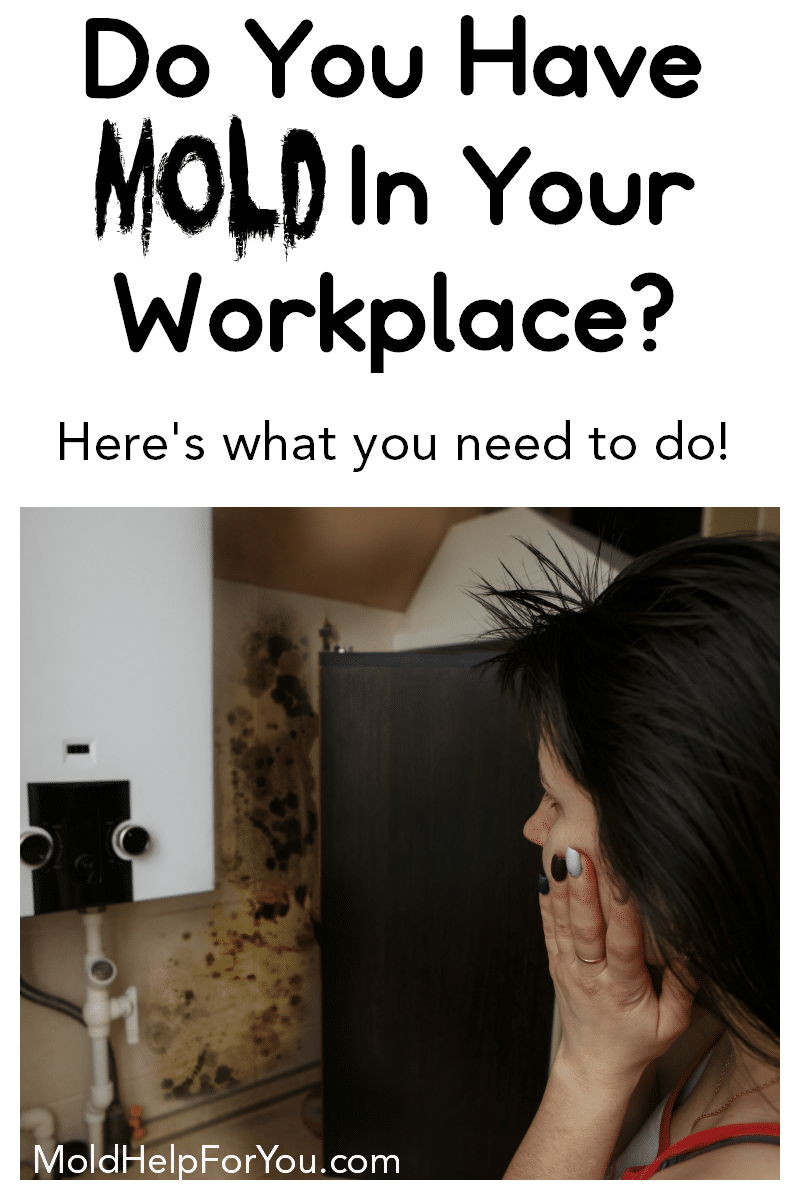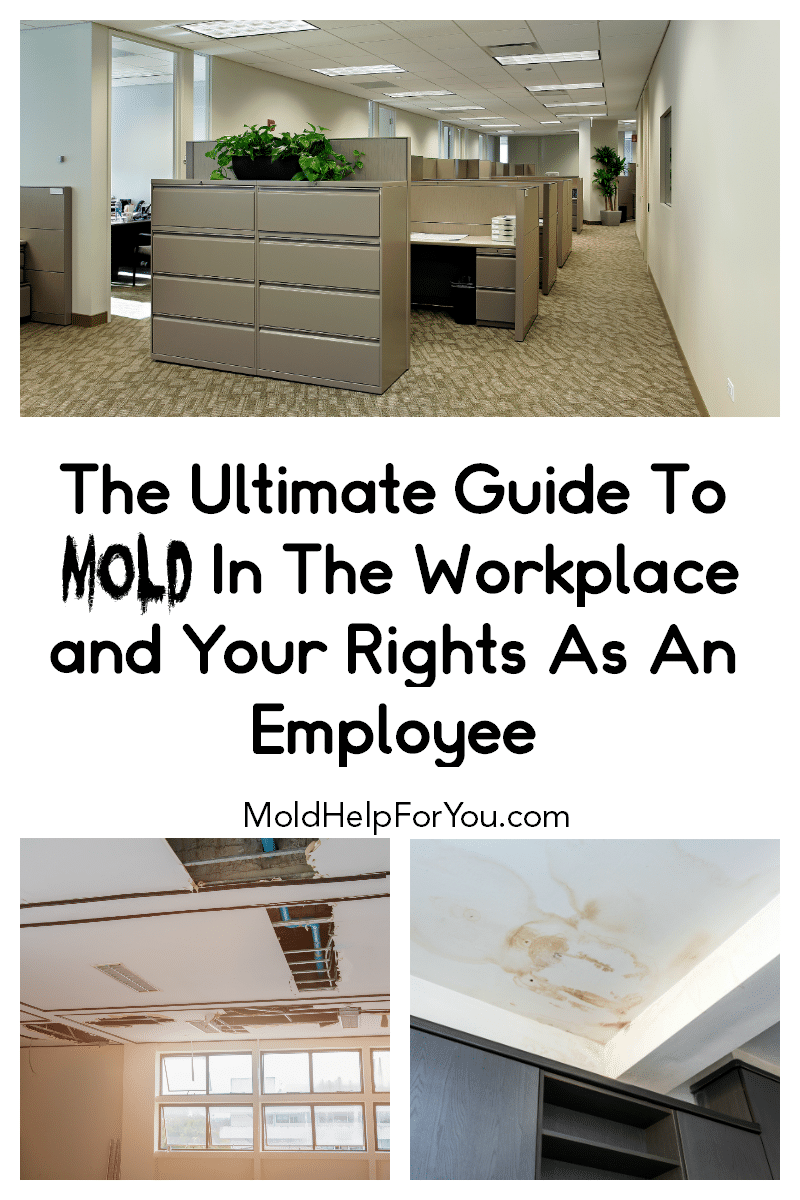Mold In The Workplace
This post may contain affiliate links. Read our full disclosure.
Whether you work in an office building, a coffee shop, a hospital, or even a junk yard, there is a strong change that you are being exposed to mold in the workplace. What should you do? What CAN you do?
Mold in the workplace, especially an office setting, is a slippery slope. More than likely your company does not own the building. This means not only dealing with the management in your own company but also bringing in the property managers or owners.
If your company does own the building, you truly are at the mercy of the management and ultimately the owners of the company.
Although mold awareness is increasing, it is still considered mainly a problem for homeowners, landlords, and tenants… not business owners. When was the last time mold crossed your mind when you went out to eat or took your car in for repairs?
Mold in the workplace, including employee rights as it relates to mold, are important topics to address. Let’s dive in to help you better understand what to do if you have or suspect mold in the workplace.

What Types Of Buildings Can Mold Grow In?
Mold can grow anywhere and on anything. No building is immune to it. Most workplaces are far dirtier than our own homes which gives mold a lot of opportunity to flourish. In addition, a lot of people come and go bringing mold spores in on their shoes, clothes, and personal belongings. Mold prevention isn’t something that is well practiced in most workplaces either.
Some buildings certainly are at higher risks for mold than other. Take a fish store for example. The amount of water and humidity in there alone will invite a mold problem. Same with a car wash or a laundromat. But what about a regular old office building?
Just like our homes, the reasons your workplace may develop a mold are:
- Lack of building maintenance
- Poor building design or construction
- Using wet building materials
- Leaky pipes, windows, or doors
- Regular, or even one-time flooding
- Simple plumbing mistakes
- Excessive humidity and condensation
- Improper landscaping design or maintenance outside the building, causing water to flow toward the building
- Appliance malfunction
What Should You Do If You Suspect Mold Where You Work?
Before getting management or the building owner riled up, I suggest you quietly run a simple mold test. This will at least give you an idea of what to do next. The vast majority of business owners and building owners are not going to do much if you come to them with a suspicion of mold when there is no visible mold or an active water leak that has gone unaddressed.
I would order a few of these test plates and send them in for analysis. This gives you more information than showing your employer a few cultures that have grown on a petri dish.
If you really want to run a test that would be difficult for an employer to ignore, you could order an EMMA test. This looks at both mold AND mycotoxins.
In addition, speak with other employees. Let them know your concerns and see if they share them. The more people who come forward, the more likely the mold issue will be addressed in a timely manner.
How Do You Report Mold In The Workplace?
Advise your manager immediately after you discover mold in the workplace through a mold test OR if you see visible mold. Report it via email so you have a record of your actions.
Start your email by saying when you first noticed the mold or tested for the mold, where you found it and how big it was. Include photos or videos.
Provide details about the environment of the location, including any visible signs of moisture or water damage. These signs might include heavy condensation on surfaces, high humidity, leaking pipes, dark stains or structural damage such as cracks on ceilings, or musty smells coming from vents or air conditioners.
If there has been a recent water event or ongoing humidity and condensation issues, include a reminder of this in your email. According to the Occupational Safety and Health Administration (OSHA), wet materials should be thoroughly cleaned and dried 24 to 48 hours after an event to prevent mold growth.
See your manager in-person if you don’t receive a timely response to your email. Tell him or her about the mold problem and that you sent him an email. If your manager remains unresponsive, speak with human resources or the company owner.
If there is still no response or if your supervisor fails to act and the mold continues to grow in your workplace, file a complaint directly with OSHA. You can file a complaint by calling your local OSHA office or online through OSHA’s website. Most state health departments and OSHA offices have their own plans in place for dealing with mold. Typically, an inspector will come look at the problem, and then decide how to proceed from there. Your employer will likely be forced to deal with the issue and get rid of the mold or face a fine.
Are There Specific Employee Rights If There Is Mold In The Workplace?
Currently, there are no federal standards or recommendations for airborne concentrations of mold or mold spores. Scientific research on the relationship between mold exposures and health effects is ongoing. As such, employers and building owners are not held to a federal standard as it relates to their employees / tenants and mold exposure.
OSHA (Occupational Safety and Health Administration) makes things worse.
OSHA’s own Safety and Health Information Bulletin entitled, A Brief Guide to Mold in the Workplace, states “concern about indoor exposure to mold has increased along with public awareness that exposure to mold can cause a variety of health effects and symptoms, including allergic reactions.”
The same bulletin includes this disclaimer: “This Safety and Health Information Bulletin is not a standard or regulation, and it creates no new legal obligations. The Bulletin is advisory in nature, informational in content, and is intended to assist employers in providing a safe and healthful workplace.”
Pursuant to the Occupational Safety and Health Act, employers must comply with hazard-specific safety and health standards and regulations promulgated by OSHA or by a state with an OSHA-approved state plan. In addition, pursuant to Section 5(a)(1), the General Duty Clause of the Act, employers must provide their employees with a workplace free from recognized hazards likely to cause death or serious physical harm. In other words, although OSHA acknowledges that mold can be a health hazard, there are no standards. Thus, employers are under no legal or regulatory obligation to provide employees with a workplace free from mold, even if the mold is making employees sick!
The volume of health policy and legal issues raised by mold contamination in the workplace are too numerous to discuss in this article (e.g., potential Americans with Disabilities Act violations, potential medical malpractice and workers compensation/personal injury claims, etc.). Even though OSHA’s policies and procedures regarding mold are draconian because they directly compromise the health of employees (a situation in direct conflict with the agency’s mission), they are the standard.
Can You Sue Your Employer For Mold In The Workplace?
Yes of course. But an attorney will only take on the case if you have already followed some very specific steps. Most of the time they will encourage you to file a Worker’s Compensation claim first. To maximize your success with either a Worker’s Comp Claim or a lawsuit, follow these 5 steps.
1. Get an evaluation from an environmental doctor OR an M.D. that has experience with mold. DO NOT seek an evaluation from any practitioner who is not an M.D. Although they may be knowledgeable and have a lot of experience with mold illness, they will not be considered credible in the eyes of the law. You can find a list of reputable “mold doctors” here.
2. Be sure to get copies of medical records regarding your exam, testing, and treatment. Being examined by a physician and following their medical advice is critical.
3. Notify your employer. Following your initial medical treatment, notify your employer. Do not wait. In some states you have only a short time to notify your employer of the injury.
4. Document the situation. Write down what you remember about your surroundings, any odor, and your health while at work as opposed to being at home or on weekends. Gather any emails your have sent to your employer as well as their response. Take photos and videos of visible mold and water damage or leaks.
5. If you’re a member of a union, make your steward aware of your injury. Your union may provide significant help.
What You Should Do About Mold If You Are A GOOD Employer / Business Owner
I take the stance that the vast majority of managers out there (notice I said managers and not business owners) want to have a healthy, mold free environment. Often their hands are tied. But in a perfect world, at the very minimum, an employer would do the following as it relates to mold in the workplace:
- Encourage all employees to practice proper mold prevention.
- Regularly inspect buildings for moisture problems including leaks.
- Prevent high indoor humidity.
- Maintain HVAC systems.
- Always respond when employees report health concerns they think are stemming from mold exposure. Encourage them to see their health care provider. Follow health care provider recommendations for relocation of employees diagnosed with building-related mold illness.
- Establish procedures for recording and responding to indoor air quality complaints.
- If your building is experiencing water penetration, consistent moisture, leaks, or has visible mold, demand that the property owner investigate the cause and promptly provide you with an action plan. If the landlord does not act give notice to your insurer. Do the same if you are the building owner.
- Develop a plan for response including proper mold remediation.
How Can You Protect Yourself From Mold In The Workplace?
- Notify your supervisor immediately if you detect any signs of flooding, dampness, musty odors or ventilation problems in your work area.
- Use a portable HEPA air purifier in your workspace. This is a great option, doesn’t make noise, and does a great job at grabbing mold spores.
- Clean your immediate area with EC3 Mold Spray. You can learn how it works in this post but in short, it will render any mold spores and mycotoxins inactive. This doesn’t solve the mold problem but it can help lesson your reaction to the mold.
- If you can burn an EC3 candle in your workplace daily, do so. Again, this will help to eliminate airborne mold spores and mycotoxins.
- Practice good mold prevention and encourage your co-workers to do the same.
- Wash your clothes with EC3 Laundry Additive and spray anything that goes between your place of business and home with EC3 before bringing it into your home.
Workplace mold is a very difficult situation and one that likely will be receiving more attention in the future. Don’t be afraid to fight for your rights as an employee. Your health and wellness depend on it.

